Abstract
The paper presents the opportunities to apply computer graphics in an object floodlighting design process and in an analysis of object illumination. The course of object floodlighting design has been defined based on a virtual three-dimensional geometric model. The problems related to carrying out the analysis of lighting, calculating the average illuminance, luminance levels and determining the illuminated object surface area are also described. These parameters are directly tied with the calculations of the Floodlighting Utilisation Factor, and therefore, with the energy efficiency of the design as well as the aspects of light pollution of the natural environment. The paper shows how high an impact of the geometric model of the object has on the accuracy of photometric calculations. Very often the model contains the components that should not be taken into account in the photometric calculations. The research on what influence the purity of the geometric mesh of the illuminated object has on the obtained results is presented. It shows that the errors can be significant, but it is possible to optimise the 3D object model appropriately in order to receive the precise results. For the example object presented in this paper, removing the planes that do not constitute its external surface has caused a two-fold increase in the average illuminance and average luminance. This is dangerous because a designer who wants to achieve a specific average luminance level in their design without optimizing the model will obtain the luminance values that will actually be much higher.
1. Introduction
Computer simulation of floodlighting is now the basic tool for any designer of such installations [1,2,3]. On its basis, the design is analysed in terms of lighting features [4,5], energy [6], and impact on the environment [7,8,9,10], and, as far as outdoor objects are concerned, its impact on the natural environment is also investigated [11,12,13]. A lighting designer has various tools and methods that are constantly improved in terms of the IT solutions [14]. When it comes to both simulation methods and tools, computer visualisations of electric lighting can be divided into three groups as follows:
- Two—dimensional (2D).
- Based on layers (2.5D).
- Three—dimensional (3D).
Each of the above-mentioned methods has some advantages and disadvantages. The undoubted advantage of two-dimensional (2D) visualisations is the speed of their development and simplicity of the tools needed to perform them. Currently, almost everybody has a mobile device that enables its user to create such visualisations (Figure 1a). These pictures can be called lighting concepts that should be verified by a lighting specialist. Making the appropriate photometric calculations, they create the final design. The specialist should select the luminaires so that the final effect meets the expectations, recommendations [15,16] or standards [17,18]. Without using any analytical software, this is quite a difficult task, requiring experience and knowledge in the field of luminaires as well as in the photometry and colorimetry areas.
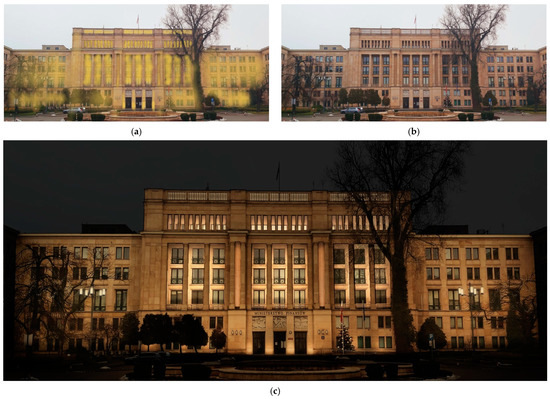
Figure 1.
Visualisation of the object illumination. (a) The 2D floodlighting concept based on (b) the daytime photo, and (c) the 2.5 D simulation of the floodlighting created on the basis of the same daytime photo.
The use of daytime photograph of the object and the application of layers in the graphic software that can be compared to a foil applied to a photo is a more advanced form of floodlighting visualisation. This type of graphics is called 2.5D. A lighting designer can obtain the effect of night illumination by covering the daytime photograph with some masking layers, most often in the form of dark single-colour raster images. Afterwards, using various tools, parts of the layers that create the night effect are removed. In this way, the photographed daytime image of the object is uncovered locally. This gives the impression of its evening illumination. Such visualisations often lead to very spectacular effects difficult to tell whether it is a simulation or photograph. However, it should be noted that, like in the 2D visualisation, this type of simulations is not correct from the technical point of view of lighting. The designer does not use the photometric parameters of luminaires and that is why they cannot determine the levels of illuminance, luminance and energy consumption needed to achieve the desired effect. However, this approach to designing the object floodlighting should not be criticised, since the object illumination is both a technical and, above all, artistic task. In most cases of illuminating the architectural objects, especially those of very attractive values, the designer should even cooperate or, at least, consult his or her assumptions with the people who have architectural knowledge. In this respect, these types of simulations are an excellent tool that is at the lighting designer’s disposal. Figure 1b shows the daytime photograph of the Ministry of Finance building in Warsaw, Poland and 2.5D simulation of floodlighting created on its basis (Figure 1c).
A visualisation based on a three—dimensional (3D) geometric model is the third type of computer simulation. It is a method that has been applied to design floodlighting solutions for more than two decades, and it is under continuous development in terms of both the methods used to create any geometric scene and the computational algorithms. Depending on time and graphic skills, the lighting designer can also use it to make photorealistic simulations [19]. Their advantage over 2.5D simulations is the fact that very often they are based on photometric data of luminaires and the 3D model which provides the basis for the generation of correct chiaroscuro. Apart from obtaining an artistically nice image, it is also possible to carry out a technically correct lighting analysis in terms of the achieved levels and distributions of illuminance, luminance as well as the light pollution of the natural environment and penetration of light into the building through window openings as far as outdoor objects are concerned. These parameters are subject to standardization restrictions. It is also possible to check the energy efficiency of the design by calculating the utilisation factor [20,21].
2. Three-Dimensional Computer Simulation of Floodlighting
Computer visualisation of floodlighting is nothing more than a graphic rendering of a given characteristic lighting condition of an object by means of an image. However, it is important that the image should adopt the quantitative features of the photometric parameters. Then computer visualisations based on the 3D model are the most accurate form of creating any floodlighting design. The geometric model developed in the virtual space makes it possible to obtain luminance and shadow distributions similar to those that will be in the reality after implementing the design. Nevertheless, to make it possible, it is necessary to remember about the conditions that such a simulation has to meet.
We can distinguish five conditions that are necessary to make a correct computer simulation of floodlighting and directly define the stages of creating a design as follows:
- A flawless geometric model.
- A measurement and correct definition of the reflectance and transmittance factor of materials in the simulation software.
- A virtual lighting scene based on the photometric data of luminaires.
- Accurate lighting calculations and rendering.
- Post-production—a collage of visualisations with evening photograph of the surroundings.
Unfortunately, the specificity of a floodlighting design cycle based on the geometric model is such that some errors made at any stage have a significant impact on the technical and visual aspect of the entire concept. This negative impact occurs regardless of the remaining steps performed correctly. A perfectly made geometric model of the object does not provide any photorealistic and technically accurate simulations, without properly defined materials and lighting calculations. Vice versa, the precisely performed calculations do not guarantee any accuracy of the design with an imperfect geometric model and incorrectly defined reflectance and transmittance factor of the materials. A very good lighting concept and correctly made photometric calculations for a poor model will not impress with their effect, either. Finally, integrating the visualisation into the photograph of the surroundings, without adjusting the exposure, will destroy a visual effect of even the best design, with all the previous stages performed correctly.
2.1. Three-Dimensional Computer Modelling
A modelling process of virtual geometric objects is a very tedious labour- and time-consuming stage of creating any computer visualisations. Depending on the object and its complexity, it also requires precision. Since the geometric modelling takes place in three-dimensional space, this task also demands appropriate knowledge and imagining of the geometry of 3D objects presented in a flat image (on a computer screen). The accuracy of rendering the real form and architectural detail of a given object determines the precision of creating the real lighting effects. The problematic question remains: What accuracy should this geometric model of the illumination object represent? The answer is not obvious. First of all, it is necessary to consider where the virtual observer will be defined in relation to the object. It can be concluded that the geometric model of the object to be illuminated by means of the computer simulation should be built with the same accuracy that arises from the need to distinguish a detail while observing the design from this observation point. Very often several main points and directions of observation are defined, and ultimately, the object is only presented from them. The exception is a computer animation and virtual reality (VR) where the observer alone can decide about the location [22,23,24,25,26]. In such cases, the model should be developed in a very detailed way [27,28].
The expected floodlighting solution is the second helpful factor. If we assume that the object illumination will emphasise its architectural detail, we should model it very accurately. If it is a planar floodlighting method and the observation points from which the design is presented and analysed are distant, modelling the detail may turn out to be a waste of time.
There are a large number of the vector-based applications used to create geometric objects. Spatial scanning can be an alternative to manual software-based modelling solutions. The technology, whose implementation was difficult in the case of floodlighting simulations a few years ago, is currently developing very quickly.
Figure 2 shows the geometric model of the Ministry of Finance building in Warsaw, Poland. It is a special object. Unfortunately, the object libraries available both on the Internet and in computer software cannot be used to build a geometric model. The time of model development, depending on the knowledge of tools, can be estimated at approximately 70 man-hours.
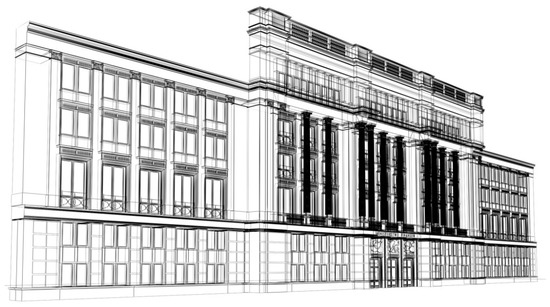
Figure 2.
The geometric representation of the object assigned for further stages of work on its floodlighting concept.
2.2. Defining Reflectance and Transmittance Factor of Materials
While the geometric object modelling can be performed in any graphic software, a computer application dedicated to these purposes should be selected for the next stages connected with creating the floodlighting design. The first condition that has to be met is the opportunity to define the physical reflectance and transmittance factors of materials. These parameters directly have an impact on both visual attractiveness of the image and its technical correctness [29]. It results straight out from the luminance formula where these parameters appear in the numerator. The error is therefore directly proportional to the mistake made when measuring and defining the reflectance and transmittance factor. After all, the change in reflectance from 0.4 to 0.5 causes a 25% difference in luminance level at the same illuminance level for a material. Luminance is a photometric quantity the human eye reacts to. Thus, the more precisely the reflectance and transmittance factor of materials is defined, the closer to reality the virtual image of the illuminated object becomes.
The properties of the materials used in floodlighting designs can be considered on the micro and macrostructure scale.
On the microscopic scale, the designer should take into account as follows:
- Reflectance factor.
- Reflectance nature that is the ratios between the directional and diffusive reflection.
- Transmittance factor.
- Transmittance nature.
- Colour of material.
It should be remembered that the real materials, especially those used in the outdoor objects are not homogeneous. They are often soiled to a different degree, and the observation distance to the illuminated object makes it possible to recognise these changes. Therefore, material parameters on the macrostructure scale should also be taken into account.
The set of these parameters includes as follows:
- Roughness.
- A surface structure.
- A so-called surface map in the form of a raster image.
- Surface irregularities.
- Surface contamination.
Defining the reflectance and transmittance factors of surface is therefore based on measuring and then representing the physical parameters of materials in the computer application in order to correct the photometric and colorimetric calculations. Figure 3 shows the rendering with properly defined reflectance and transmittance factors of materials, with the use of neutral daylight. Such an image also makes it possible to control the proportions between the materials.
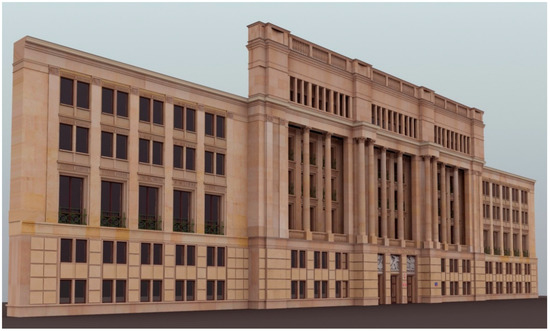
Figure 3.
Rendering showing the correctly defined reflectance and transmittance factors of materials used in the object, with the use of daylight.
The geometric and material scene created in this way is a basis for carrying out a technically correct design process and lighting analysis in graphic software products. There are a large number of applications (software packages) on the graphics market, but only those that make it possible to define reflectance and transmittance factors of materials are the accurate tools from the lighting point of view. Some producers of graphic applications are aware of this and do not offer a luminance analysis in their products, they just provide an illuminance measurement.
2.3. Creating a Virtual Lighting Scene
Developing an object floodlighting concept may or may not have to be preceded by the methods connected with 2D and 2.5D graphics. This step can also be performed in 3D graphics software directly. To make it technically correct, however, the proper software packages have to be used again. The designer should choose only those that allow him or her to use the luminous intensity distribution files of luminaires as well as to change the basic photometric parameters, such as maximal luminous intensity of luminaire, luminous flux, colour temperature of light source as well as its shape and dimensions. Currently, in their databases most companies operating on the lighting market have a wide range of photometric equipment in their product offer. The photometric files of luminaires recorded mainly in the IES (the Illuminating Engineering Society) format and in the LDT (EULUMDAT), which is the European counterpart, are available without any restrictions from the website level. These virtual luminaires are arranged in a 3D scene in accordance with the design assumptions.
2.4. Lighting Calculations—Rendering
Even the most accurately reproduced geometric model of the object, the appropriately defined material properties and the best lighting concept do not guarantee a correct result of computer visualisation without any precisely defined calculation parameters.
Computing in virtual space is called rendering. It is a calculation process used to process the mesh model of (vector) object into a raster form with all its features arising from the adoption of reflectance and transmittance factors and the specific lighting method. In this process, by means of the algorithms used to simulate the software, the photometric and colorimetric calculations are performed. As a result of them, each point of the object obtains a calculated illuminance value which is then converted into the luminance and the colour. These parameters are directly presented on the computer screen in the form of a pixel matrix creating the final image. The applied computational algorithms are based on the formulas derived directly from the theory of lighting technology. Therefore, a technically performed visualisation in terms of lighting is the result of rendering.
The advantage of designing the floodlighting for outdoor objects compared to interiors is the fact that there is a slightly indirect component of the illuminance, and that is why theoretically, the calculations are relatively simple and faster.
Figure 4 shows the final rendering of the floodlighting concept of flawless geometric model with correctly defined material properties.
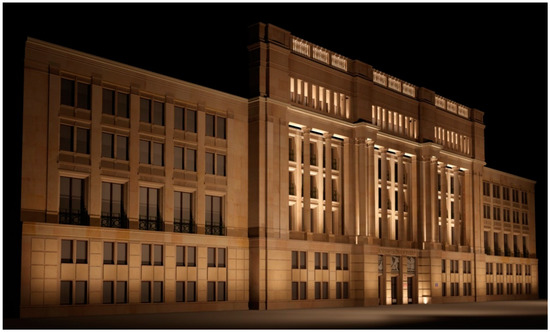
Figure 4.
The final rendering of the object floodlighting concept.
2.5. Post-Production—A Collage with the Evening Photo
A collage of the computer graphics and the evening photo of object is often a spectacular culmination of any design. As research shows [30], the properly made collage determines its recognition whether it is a design or a photo of the illuminated object. However, the collage of the picture and the rendering is not always feasible. While the objects obscuring the real object, such as trees, road infrastructure, are not a major problem because they can be removed from the photo, the observation perspective may exclude the use of this stage of creating the design.
In order to make the post-production in the form of the collage successful, the following conditions have to be met:
- The photo has to be taken with the controlled exposure parameters.
- The rendering should be performed with the same exposure parameters as the photo has been taken.
- The computer simulation has to take into account the luminance levels of the object implemented with the ambient light that occurred during the evening photo.
- The direction and point of virtual observation should be compliant with the real one where the photo has been taken.
Figure 5 shows the process of creating the collage of the rendering and the evening photo of the object: Figure 5a—the evening picture, Figure 5b—reproducing the real illuminance and luminance levels and distributions of the object and its surroundings occurring while taking the photo and Figure 5c—switching-on the illumination luminaires used in the design presented in Figure 5 virtually.
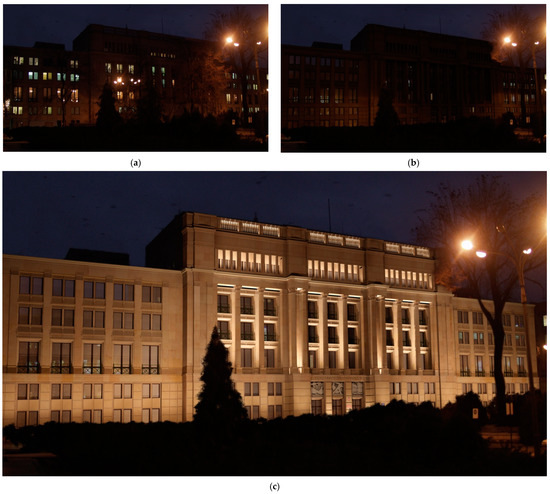
Figure 5.
Stages of creating the collage of the rendering and the evening photograph of the object. (a) The evening photo of the object, (b) the object illuminated by the level of illuminance corresponding to the conditions under which the photograph was taken, (c) the final floodlighting design.
The collage of computer graphics and photo made in this way provides photorealism. The achieved effect is difficult to identify and state that it is graphics and not a photograph. However, the most important thing is that it is a technically correct image. It can be said that the photo taken after the implementation of the design will look in this way—of course, at the same time of the day and the year, and if the same exposure conditions, under which the photograph used in the design has been taken, are maintained.
3. A Lighting Analysis Based on 3D Computer Graphics
However, it should be remembered that without any appropriate technical documentation, photorealistic renderings represent only an image attractive to the human eye. The perception of this image, and thus of the design, depends on a large number of factors. It will be perceived in a completely different way in a darkened room and in a brightened one. It will also depend on its size and the observation distance. The medium where the image will be presented will also be significant. The visual perception will be different as far as a printout is concerned and it will be completely different when it comes to any electronic device. That is why in order to maintain the technical aspect of the floodlighting design based on computer visualisation, the isolines and falsecolour images are used in the lighting analysis process. They show the changes in both illuminance and luminance levels. Only such documentation can be the technical side of the design. Unfortunately, this is often neglected. If the decisions about a method of floodlighting are made only on the basis of traditional visualisations/renderings, the effect may differ from the intended one after implementing the design. The differences can occur in both luminance distribution and levels. In such cases, the photorealistic visualisation can be satisfactory and attractive to the human eye; however, unfortunately, the technical parameters such as illuminance, and especially luminance, cannot be analysed on their basis. The exception is the use of virtual reality (VR) technology [31,32,33], but it requires an appropriate system calibration based on luminance measurements [34,35].
The lighting analysis based on falsecolour photography is carried out by observing a multi-coloured image with a legend. Therefore the lighting designer has to have extensive experience in reading it. It is difficult to evaluate the exact mean value of any photometric parameter on the basis of the raster image. As far as the object illumination is concerned, it is the average luminance value that is the basic parameter given in the report of the International Commission on Illumination (CIE) in “Guide for Floodlighting” [15]. Also, falsecolour images have to be properly scaled, which is often forgotten, especially by the beginners-designers using this method for creating the designs. The selection of the scale is crucial for a correct readout. Figure 6 shows the floodlighting design with the application of three different luminance ranges: (a) 0—15 cd/m2, (b) 0—50 cd/m2, (c) 0—150 cd/m2. The selection of the range 0—150 cd/m2 is theoretically recommended for this design, as the maximum point luminance values in the design are 150 cd/m2, i.e., in this range all values will be represented by the image. When creating the falsecolour images, we should avoid seeing the colour corresponding to the maximum luminance value of the scale (red) in them, whereas the real one in the design is higher (the colour will also be red). The scale cannot be too wide, either. For example, if the range of 0—500 cd/m2 is used, the whole will become uniform with the values from the lower range of scale. When analysing the luminance levels for area 1 marked in Figure 6a, it can be observed that the luminance level evaluation is not easy. Based on this figure, it can be concluded that the luminance values for this area are in the range of between 10 and 20 cd/m2. On the other hand, in Figure 6b the values can be read as close to 6 cd/m2, whereas in Figure 6c, which is recommended because of the maximum values obtained, the readout returns to about 12 cd/m2 again. However, is this really the value in this area? It seems that to make the correct evaluation, the application of the image in Figure 6a is the most recommended solution. Unfortunately, in this image, the remaining values for the design are misrepresented. Being governed by the colour of the image, the local luminance values in the balcony spaces can be estimated 10 times lower. The assessment of the average value for the entire object will be burdened with an error.
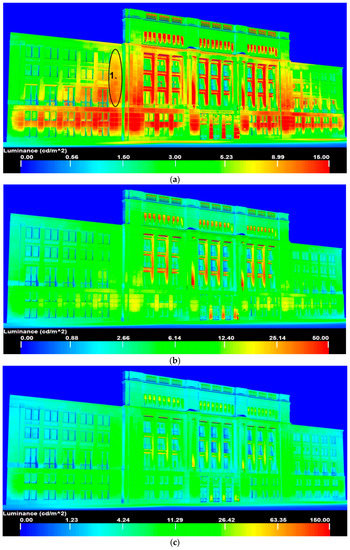
Figure 6.
The same luminance distribution shown by means of the falsecolour image using different ranges: (a) 0–15 cd/m2, (b) 0–50 cd/m2 and (c) 0–150 cd/m2.
It can also happen that there are few areas with the values in the upper range of the scale in the falsecolour image–for example, in the accent floodlighting method. Then, adjusting the scale range to the maximum values obtained in the design, the remaining luminance values represented by the colours and their differentiation may not be perceptible to the human eye. The perception of colour by the human eye, i.e., the correct readout of the illuminance or luminance levels and the estimation of the average values of these parameters will be impossible. This problem can also be observed when analysing Figure 6. The illumination of the side façades of the building is characterised by the fairly uniform illuminance and luminance distribution as well as the values are much lower than in the central part. In Figure 6a, however, a greater differentiation in luminance can be observed compared to the image in Figure 6b,c, where the range is extended. While analysing these figures, an impression of different levels of the average luminance for the entire object can be gathered, too. This shows how dangerous the analysis based on a falsecolour image is.
Knowing the exact mean value of the luminance for the design, the decision was made to do a dozen tests, asking the respondents to estimate the average luminance distribution value with the accuracy of 1 cd/m2. None of the respondents gave the correct answer. Interestingly, in each of the cases the given value was overestimated. In the test group there were also the people who said it was impossible to do it and they would not undertake such an assessment. These people were familiar with this problem.
The incorrect analysis of illuminance and luminance carried out in this way will have a negative impact on the correct result of the floodlighting utilization factor, and thus, on the assessment of the energy efficiency of the design and the degree of light pollution of the natural environment. That is why there is a need to consider how to solve these problems.
The aim of further research was to check a chance of carrying out the lighting analysis directly on the geometric model, and not on the raster image.
4. Methodology
Most computer software products used for the lighting analysis make it possible to build virtual measurement planes. When it comes to interiors and geometrically simple objects, this method works out very well. As far as outdoor architectural objects are concerned, when wanting to apply this method, these measuring planes should be put on each of the planes creating the object and, what is important, they should be analysed together. This would be a very complicated and inefficient process comparable to recreating the geometric object from the measuring planes this time. Some computer packages have some special tools that enable the measurement of photometric parameters directly on the object regardless of its shape. It is possible to measure both the average value, which is of the highest interest to us, and the point value by pointing, for example, any place on the object, with the mouse cursor. Autodesk 3ds Max is one example of this kind of software. Unfortunately, while the point measurement is correct, the mean value may be burdened with an error that is difficult to define. This is not the computational algorithm fault. The error primarily depends on the construction of the geometric model, which means on the user. Very often this model consists of the planes that do not have an impact on the lighting effect. The larger the surface area of these object components is, the bigger the mistake will be. There will be a zero illuminance on their planes, lowering the average value. It is therefore necessary to check how serious the error can be and whether it can be accepted—possibly how to eliminate or minimize it.
To check this, some calculations will be made for the average values of illuminance, luminance, object surface area and utilisation factor for the analysed object, both in its original form (its model created in a standard way) and dedicated one to such calculations. The object will then be cleared of redundant invisible planes. These planes are, for example, the contact surfaces of each pilaster, columns, cornices, all architectural details and all parts of the objects penetrating the façade.
Figure 7 presents a flowchart scheme of the methodology procedure. Having the geometric model (3D Model), the photometric data of luminaires and the defined material properties, the object model is optimized until the average level of illuminance is stabilized. If this occurs, the average luminance level on the object is calculated based on the reflectance and transmittance factors of the materials. Each time, the surface area of the object is computed and the useful luminous flux is determined. Knowing the luminous flux of all light sources, the Floodlighting Utilisation Factor is calculated.
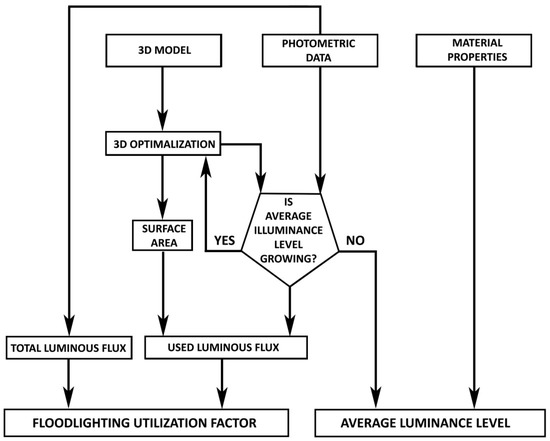
Figure 7.
The flowchart scheme of the methodology procedure.
5. Results and Discussion
5.1. A Lighting Analysis of the Three-Dimensional Geometric Model
The virtual geometric model of the analysed object – the Ministry of Finance building, Warsaw was made in the Autodesk 3ds Max software. When creating it, no attention was paid to the interpenetrating planes. A lot of architectural elements are built with a given thickness. The walls are a typical example. While modelling them, it was faster and more convenient to make their cross-section and then extrude the solids on their basis. It can be stated that the entire object is a set of the appropriately modelled and placed solids instead of the planes constituting its outer surface (Figure 2).
As the lighting analysis function of Autodesk 3ds Max presented in Figure 8 shows in this case, the surface area of the object is S = 10,640.129 m2. Certainly, the value is overstated, but it is hard to say how much. The direct measurement of the average illuminance taken on the object gives the result Eav = 19.518 lx. The average luminance is Lav = 3.342 cd/m2 and at the point in the centre of area 1 in Figure 6a is approximately 8 cd/m2. This result is consistent with what can be read from this figure.

Figure 8.
A measuring window for the lighting analysis function for (a) illuminance and (b) luminance in the floodlighting design carried out by means of the classical 3D model.
Knowing the photometric parameters of luminaires, with the use of dependences (1) and (2), it is possible to calculate the Floodlighting Utilisation Factor.
where:
ϕu = Eav ⋅ S
FUF—is the Floodlighting Utilisation Factor.
ϕu—is the luminous flux performing the average illuminance Eav on the object.
ϕt0—is the luminous flux of all light sources installed in the luminaries used to illuminate the object.
Eav—is the average illuminance level on the object.
S—is the surface area of the object.
In the analysed design, 87 luminaires were used, and their total luminous flux of the all light sources is ϕt0 = 428,945 Lm. The useful luminous flux, which performs the average illuminance Eav = 19.518 lx, is therefore ϕu = 207,674 Lm. Based on these data, it can be calculated that the Floodlighting Utilisation Factor (FUF) is at the level of 48%.
As for the floodlighting, the Floodlighting Utilisation Factor is relatively high because the luminaires with the light emitting diodes (LEDs) of the luminous efficacy of the luminaires equal to 100 Lm/W declared by the manufacturer were used. The colour temperature of the light sources is T = 3000 K.
The calculations did not take into account the ambient light that was considered in the collage creation process.
As this example shows, the lighting analysis of the object carried out on the geometric model made it possible to easily calculate the Floodlighting Utilisation Factor and to carry out the lighting analysis of the object. The average illuminance and luminance levels are lower than the minimum levels recommended in the CIE Report no. 94 [15]. However, it should be remembered that they are understated as a result of including the object components where there are zero values. Unfortunately, there is a risk that the designer using this method will not be aware of this fact and, in order to meet the CIE recommendations, they will decide to increase the luminous flux, and thus the installed power. It will be an inefficient energy solution.
5.2. A Lighting Analysis of the Geometric Model Dedicated to the Photometric Calculations
In accordance with the accepted assumption, at the next step of research, the geometric mesh of the original model was optimised by removing the unnecessary planes. Figure 8 shows the object model optimised towards the photometric calculations. When analysing Figure 2 and Figure 9, a significant reduction in number of the edges can be observed, and that is why the model is smaller in surface area.
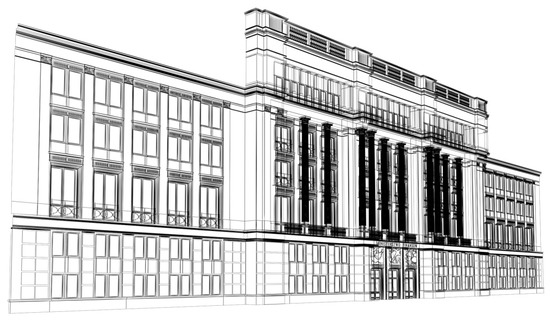
Figure 9.
The geometric object model optimised towards the photometric calculations.
Of course, the visual image of the design did not change. While performing the analysis of such an optimised model, the computer software calculated that the surface area decreased to S = 5405.485 m2, i.e., almost by a factor of two (Figure 10). This change, of course, also had an impact on the average illuminance level, which went up almost twice (Eav = 38.483 lx), too. The average luminance level went up automatically (Lav = 6.545 cd/m2). As it turns out, the achieved values are within the ranges recommended for this type of the objects, in the environment where it is located. It can also be said that the results are real.

Figure 10.
A measuring window for the lighting analysis function for (a) illuminance, (b) luminance in the floodlighting design made on the 3D model optimised towards the photometric calculations.
The average luminance Lav difference between the calculations for the original model and after the optimisation is up to 3.2 cd/m2. Referring this value to the recommendation for the average luminance values on the illuminated objects, this is the first luminance level recommended for the floodlit objects by the CIE. Therefore, it should be considered that the error resulting from the calculation of the average illuminance and luminance values is very big and if the lighting designer were not aware of it, after implementation the uncontrolled oversizing would occur compared to the design assumptions. When wanting to achieve the recommended 6 cd/m2, they would actually perform a twice higher value. This would adversely affect both the lighting effect and parameters connected with glare, light pollution of the natural environment and economy.
Table 1 presents a comparison of all the calculated data for the object before and after the optimisation of the geometric model.

Table 1.
The calculated surface and photometric parameters for the object before and after its optimisation.
While analysing the values from Table 1, it can be observed that the useful luminous flux went up as for the optimised model. This is a result of removing some planes that were illuminated, however. It applies to the components on the balconies that were invisible, therefore, initially modelled carelessly.
Unfortunately, the preparation of this geometric model for such calculations involves some additional work. As far as the presented example is concerned, it was about 20 man-hours, therefore, less than 30% of the time needed to model the original object. This time comes from a degree of the complexity of the geometric mesh. It was necessary to carefully analyse which planes should be removed and which left in the model. Of course, it can be assumed that this geometric model for this type of analysis will be prepared from the very beginning. Then this additional time will probably be much shorter. However, it should not be expected that it could be close to the time of the traditional geometric modelling of architectural objects. When creating an object, computer graphic designers usually do not care about any details that are invisible in the rendering. In order to obtain a half-column, they design a whole solid that is axially rotational and insert it into the façade. To have the properly made photometric calculations, a half of this column should be removed and a hole in the façade should be cut along the outline of the half-column. Very often models used by lighting designers are a basis of designs from other industries, e.g. in the Building Information Modelling (BIM) system [36]. Then lighting designers have no way out. In order to carry out a technically correct and accurate lighting analysis, they have to do this additional time-consuming and sometimes difficult work. Unfortunately, in the BIM system there can be a lot of unnecessary model information from the lighting point of view. Such models include an object infrastructure, interior walls, etc.
Fortunately, the geometric model does not have an impact on the result of the floodlighting utilisation factor calculation. Despite the fact that with the optimisation towards the accurate analysis of the illuminance and luminance distribution, the average values of these photometric parameters increase, the surface area decreases, and that is why the floodlighting utilisation factor remains at the same level. Therefore, it can be stated that the presented method based on the geometric model, no matter how it is built, even with interior equipment, is suitable for any direct analysis of the floodlighting utilisation factor, and thus for the evaluation of the energy efficiency of the design and the degree of light pollution caused by its later implementation.
As the research shows, the proposed method made the calculations of the average illuminance and luminance values become very accurate. Unfortunately, it takes a lot of time needed to develop the model and perform the photometric calculations. Also, the density of the measuring grid (the number of measuring points) has an impact on the computation time and the accuracy. Increasing the density means dividing the geometric object. The software divides each part of the façade in the shape of, for example, one rectangle, into a set of smaller ones. This, in turn, causes more strain on the computer CPU. As for the analysed case, in order to obtain the information about the average illuminance and luminance level directly from the software, the calculation time was up to 3 h. Compared to approximately the 20-min calculations for the typical division whose result is a photorealistic visualisation in the form of the raster image, it is almost a 10-fold rise in time. As far as a planar floodlighting method is concerned, the grid density is not so important because the object is illuminated uniformly. The problem appears only when it comes to the illuminated objects with the high diversity. In such cases, the geometric model should be divided as densely as possible, but also, it is difficult to indicate a specific value. In general, it can be said that the degree of division should be directly proportional to the degree of non-uniformity of the floodlighting of the object.
A mid-range computer with the Intel® Core i7 CPU processor, with 16 GB RAM was used to model the object and perform the photometric calculations. As far as the geometric modelling is concerned, it did not really matter. However, if better computer hardware is used for the lighting calculations, it is expected that the given time should be shortened.
6. Conclusions
The proposed five-stage design process provides a photorealistic simulation. Unfortunately, this is a labour- and time-consuming task. It mainly arises from a need to create the geometric model. Until now this has been the biggest problem for lighting designers. Today, however, the visualisation technology is very popular in most industries. Very often a geometric model designed by one industry is used in the remaining branches. As the research has shown, unfortunately, the standardly developed geometric models that serve construction and visualisation purposes are not suitable to make any accurate photometric calculations in most cases. On the other hand, relying on raster images of illuminance or luminance distributions, the designer may make the errors that are difficult to estimate. The geometric model of the object dedicated to these calculations is a solution. Only in this case the numerical analysis of lighting works out and the designer does not make any mistakes. In other cases, visualisations with the use of a 3D model can only be used as a basis for preliminary estimation of the value of the illuminance and luminance level as well as visual/artistic assessment of the floodlighting design. Fortunately, the 3D model does not have an impact on the floodlighting utilization factor. That is why it is possible to conclude that the analysis of this parameter can be performed without the need to optimise it. The evaluation of the floodlighting utilisation factor and the impact of outdoor lighting on the degree of light pollution of the natural environment based on 3D graphics are therefore relatively simple.
Funding
This research received no external funding.
Data Availability Statement
The data presented in this study are available on request from the author.
Acknowledgments
Article Preparation Charge was covered by the Electrical Power Engineering Institute at The Warsaw University of Technology and the Open Access Charge was covered by the IDUB program at the Warsaw University of Technology.
Conflicts of Interest
The authors declare no conflict of interest.
References
- Mahdavi, A.; Eissa, H. Subjective evaluation of architectural lighting via computationally rendered images. J. Illum. Eng. Soc. 2002, 31, 11–20. [Google Scholar] [CrossRef]
- Baloch, A.A.; Shaikh, P.H.; Shaikh, F.; Leghari, Z.H.; Mirjat, N.H.; Uqaili, M.A. Simulation tools application for artificial lighting in buildings. Renew. Sustain. Energy Rev. 2018, 82, 3007–3026. [Google Scholar] [CrossRef]
- Schwarz, M.; Wonka, P. Procedural Design of Exterior Lighting for Buildings with Complex Constraints. ACM Trans. Graph. 2014, 33, 1–16. [Google Scholar] [CrossRef]
- Mazur, D.; Wachta, H.; Leśko, K. Research of cohesion principle in illuminations of monumental Objects. Lect. Notes Electr. Eng. 2018, 452, 395–406. [Google Scholar] [CrossRef]
- Moscoso, C.; Chamilothori, K.; Wienold, J.; Andersen, M.; Matusiak, B. Window Size Effects on Subjective Impressions of Daylit Spaces: Indoor Studies at High Latitudes Using Virtual Reality. LEUKOS J. Illum. Eng. Soc. N. Am. 2020, 1–23. [Google Scholar] [CrossRef]
- Valetti, L.; Floris, F.; Pellegrino, A. Renovation of Public Lighting Systems in Cultural Landscapes: Lighting and Energy Performance and Their Impact on Nightscapes. Energies 2021, 14, 509. [Google Scholar] [CrossRef]
- Leccese, F.; Salvadori, G.; Maccheroni, D.; Feltrin, F. Lighting and visual experience of artworks: Results of a study campaign at the National Museum of San Matteo in Pisa, Italy. J. Cult. Herit. 2020, 45, 254–264. [Google Scholar] [CrossRef]
- Luengo, P. Sustainable illumination for baroque paintings with historical context considerations. Sustainability 2020, 12, 8705. [Google Scholar] [CrossRef]
- Pracki, P.; Krupiński, R. Brightness and Uniformity Perception of Virtual Corridor with Artificial Lighting Systems. Energies 2021, 14, 412. [Google Scholar] [CrossRef]
- Vitsas, N.; Papaioannou, G.; Gkaravelis, A.; Vasilakis, A.A. Illumination-Guided Furniture Layout Optimization. Comput. Graph. Forum 2020, 39, 291–301. [Google Scholar] [CrossRef]
- Vega, C.P.; Zielinska-Dabkowska, K.M.; Hölker, F. Urban lighting research transdisciplinary framework—a collaborative process with lighting professionals. Int. J. Environ. Res. Public Health 2021, 18, 624. [Google Scholar] [CrossRef]
- Saraiji, R.; Oommen, M.S. Light pollution index (LPI): An integrated approach to study light pollution with street lighting and façade lighting. LEUKOS J. Illum. Eng. Soc. N. Am. 2012, 9, 127–145. [Google Scholar] [CrossRef]
- Skarżyński, K. Methods of calculation of floodlighting utilisation factor at the design stage. Light Eng. 2018, 26, 144–152. [Google Scholar] [CrossRef]
- Krupiński, R. Luminance distribution projection method in dynamic floodlight design for architectural features. Autom. Constr. 2020, 119. [Google Scholar] [CrossRef]
- Commission Internationale del’Eclairage (CIE). Guide for Floodlighting; Technical Report nr 94; Commission Internationale del’Eclairage (CIE): Vienna, Austria, 1993. [Google Scholar]
- Commission Internationale del’Eclairage (CIE). Guide on the Limitation of the Effects of Obtrusive Light from Outdoor Lighting Installations, 2nd ed.; Technical Report 150; Commission Internationale del’Eclairage (CIE): Vienna, Austria, 2017. [Google Scholar]
- European Standard EN 12464-1:2011. Light and Lighting—Lighting of Work Places—Part 1: Interior Work Places; CEN: Brussels, Belgium, 2011. [Google Scholar]
- European Standard EN 12464-2. Lighting of Work Places—Part 2: Outdoor Work Places; Lumière. EN: Brussels, Belgium, 2007. [Google Scholar]
- Wachta, H.; Bojda, P. Usability of luminaries with LED sources to illuminate the window areas of architectural objects. 2016 Sel. Issues Electr. Eng. Electron. WZEE 2016 2016, 1–6. [Google Scholar] [CrossRef]
- Skarżyński, K. Field measurement of Floodlighting Utilisation Factor. In Proceedings of the 2016 IEEE Lighting Conference of the Visegrad Countries (Lumen V4), Karpacz, Poland, 13–16 September 2016. [Google Scholar] [CrossRef]
- Pracki, P.; Skarżyński, K. A multi-criteria assessment procedure for outdoor lighting at the design stage. Sustainability 2020, 12, 1330. [Google Scholar] [CrossRef]
- Shi, Y.; Du, J.; Ahn, C.R.; Ragan, E. Impact assessment of reinforced learning methods on construction workers’ fall risk behavior using virtual reality. Autom. Constr. 2019, 104, 197–214. [Google Scholar] [CrossRef]
- De Klerk, R.; Duarte, A.M.; Medeiros, D.P.; Duarte, J.P.; Jorge, J.; Lopes, D.S. Usability studies on building early stage architectural models in virtual reality. Autom. Constr. 2019, 103, 104–116. [Google Scholar] [CrossRef]
- Jin, Y.H.; Hwang, I.T.; Lee, W.H. A mobile augmented reality system for the real-time visualization of pipes in point cloud data with a depth sensor. Electronic 2020, 9, 836. [Google Scholar] [CrossRef]
- Paes, D.; Arantes, E.; Irizarry, J. Immersive environment for improving the understanding of architectural 3D models: Comparing user spatial perception between immersive and traditional virtual reality systems. Autom. Constr. 2017, 84, 292–303. [Google Scholar] [CrossRef]
- Lee, J.G.; Seo, J.; Abbas, A.; Choi, M. End-Users’ Augmented Reality Utilization for Architectural Design Review. Appl. Sci. 2020, 10, 5363. [Google Scholar] [CrossRef]
- Heydarian, A.; Carneiro, J.P.; Gerber, D.; Becerik-Gerber, B. Immersive virtual environments, understanding the impact of design features and occupant choice upon lighting for building performance. Build. Environ. 2015, 89, 217–228. [Google Scholar] [CrossRef]
- Jiménez Fernández-Palacios, B.; Morabito, D.; Remondino, F. Access to complex reality-based 3D models using virtual reality solutions. J. Cult. Herit. 2017, 23, 40–48. [Google Scholar] [CrossRef]
- Zhang, Y.; Liu, H.; Zhao, M.; Al-Hussein, M. User-centered interior finishing material selection: An immersive virtual reality-based interactive approach. Autom. Constr. 2019, 106, 102884. [Google Scholar] [CrossRef]
- Krupiński, R. Evaluation of Lighting Design Based on Computer Simulation. In Proceedings of the 2018 VII. Lighting Conference of the Visegrad Countries (Lumen V4), Trebic, Czech Republic, 18–20 September 2018; pp. 1–5. [Google Scholar] [CrossRef]
- Chamilothori, K.; Wienold, J.; Andersen, M. Adequacy of Immersive Virtual Reality for the Perception of Daylit Spaces: Comparison of Real and Virtual Environments. LEUKOS J. Illum. Eng. Soc. N. Am. 2019, 15, 203–226. [Google Scholar] [CrossRef]
- Heydarian, A.; Pantazis, E.; Carneiro, J.P.; Gerber, D.; Becerik-Gerber, B. Lights, building, action: Impact of default lighting settings on occupant behaviour. J. Environ. Psychol. 2016, 48, 212–223. [Google Scholar] [CrossRef]
- Heydarian, A.; Pantazis, E.; Wang, A.; Gerber, D.; Becerik-Gerber, B. Towards user centered building design: Identifying end-user lighting preferences via immersive virtual environments. Autom. Constr. 2017, 81, 56–66. [Google Scholar] [CrossRef]
- Chen, Y.; Cui, Z.; Hao, L. Virtual reality in lighting research: Comparing physical and virtual lighting environments. Light. Res. Technol. 2019, 51, 820–837. [Google Scholar] [CrossRef]
- Krupiński, R. Virtual reality system and scientific visualisation for smart designing and evaluating of lighting. Energies 2020, 13, 5518. [Google Scholar] [CrossRef]
- Khudhair, A.; Li, H.; Ren, G.; Liu, S. Towards Future BIM Technology Innovations: A Bibliometric Analysis of the Literature. Appl. Sci. 2021, 11, 1232. [Google Scholar] [CrossRef]
Publisher’s Note: MDPI stays neutral with regard to jurisdictional claims in published maps and institutional affiliations. |
© 2021 by the author. Licensee MDPI, Basel, Switzerland. This article is an open access article distributed under the terms and conditions of the Creative Commons Attribution (CC BY) license (http://creativecommons.org/licenses/by/4.0/).